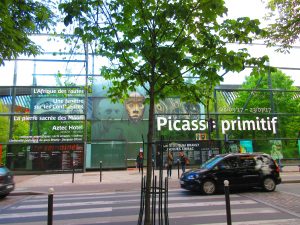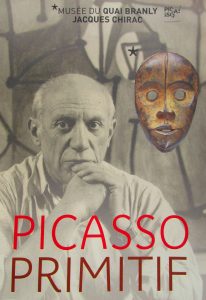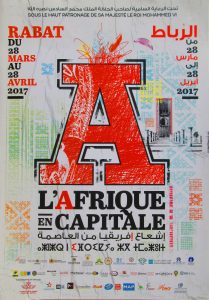CAA News Today
Africa at the Quai Branly Museum and the Mohammed VI Museum for Modern and Contemporary Art: Challenges for Exhibitions of African Art
posted Nov 16, 2017
Colette Apelian, an art historian based in Rabat, Morocco and Los Angeles, California, was invited to submit the following article by Pearlie Rose S. Baluyut, a member of CAA’s International Committee. Apelian holds a PhD in art and architectural history and an MA in Islamic studies from UCLA.
Do museums fail visitors and benefactors when they allow the use of objects to present what many might consider selective histories and definitions of identities? The answer may well be yes, a response that struck me after I visited Picasso Primitive or Primitive Picasso (Picasso Primitif) at the Quai Branly Museum (Musée du Quai Branly; MQB) in Paris, France (March 28–July 23, 2017) and Africa in the Capital City (L’Afrique en Capitale) at the Mohammed VI Museum for Modern and Contemporary Art (Musée Mohammed VI d’Art Moderne et Contemporain; MMVI) in Rabat, Morocco (March 28–July 31, 2017).

Quai Branly Museum façade. Photo by author.
At the MQB, what can be described as Pablo Picasso’s peccadillos were vaulted as examples of artistic genius and the result of his contact with African artifacts. As visitors walked through the exhibition, they could see Picasso’s art and writings, or reproductions thereof, juxtaposed with African masks, sculptures, and seminude postcard representations of Malinke and Sudanese women. The exhibition included objects Picasso collected, viewed in the Trocadero Ethnography Museum, and/or traded with fellow, mostly male, artists. Curatorial wall texts and a brochure in French and the occasional English explained how Picasso’s figural abstraction defined modern art.
Still, the exhibition could have used more clarification. I wondered why, especially in light of displays in other Parisian museums, the MQB thought visitors would find the Picasso-great-man and artist myth appropriate. The privileging of Picasso and his primitivism in an undefined modern art history was underexplained. Most of the nude bodies and, according to wall texts, the “disfigured” “monster” faces he created were predominantly of females with apparently unremarkable lives or histories beyond Picasso’s use. The suggestion that Picasso made tableaus of stylized penises in response to his exposure to African statues with erect phalluses did not seem to adequately explain his fascination with human sexuality.

Picasso Primitive brochure cover detail. Photo by author.
Perhaps odder still was how the MQB left unpacked and decontextualized the notion of the primitive. The museum’s (and/or Picasso’s ?) definition all but ignored the history of this term and, as such, the discourse about it and the Other. In so doing, the show affirmed yet again an ethnocentric characterization of the MQB that James Clifford, among others, criticized the museum for entrenching after its 2006 opening. (See James Clifford, “Quai Branly in Process,” October, Spring 2007, 3–23.) The effects of refusing to detangle and define primitive were compounded by the relative lack of wall and brochure text explaining the history, circumstances of acquisition and display, and the socioreligious significances of most masks and statues shown or referenced in the exhibition. It was compounded by the MQB not sufficiently clarifying the sociopolitical and economic contexts in which Picasso traded images of unclothed Africans and created and sold art. In the 2010 Spectacular Art of Jean-Léon Gérôme exhibition at the J. Paul Getty Center in Brentwood, California (June 15–September 12, 2010), visitors learned that Gérôme’s prurient Orientalism was cultivated in relation to the contemporary European marketplace. The perhaps unintended impression that Primitive Picasso organizers hoped to titillate for monetary profit at the expense of the Other was accentuated by the absence of a similar analysis, if indeed the artworks on display were created for public, not private, consumption. Consumption was also underclarified.
More explanation was additionally necessary in the wall texts and brochures for Africa in the Capital. The largest section of the show was staged in the museum named after the king of Morocco, Mohammed VI. Here, visitors walked through rooms of paintings, sculpture, and photography that, according to one brochure, celebrated African creativity, African identity, African culture, the African art scene, and, in the case of at least one artist, humanity removed from racial identifiers. Exhibition materials informed us that the works of art were created by North and/or sub-Saharan Africans, including artists born and/or living off the continent. One example is the Moroccan-French photographer Leila Alaoui, who died shortly after a 2015 Burkina Faso terrorist attack while she was on assignment for Amnesty International. She was born in Paris and resided and worked in Europe, the United States, and Morocco. Alaoui, with her strong sense of injustice and interest in immigration, would probably note that the ability of some artists to easily move across borders is an elite privilege, an important distinction I could not find in exhibition materials. I could also see little discussion about the influences and significance of living and making art in diaspora cultures. The contradictions of an exhibition that was meant to celebrate diversity, yet included artists based upon ancestry alone, appeared lost on the organizers.

Africa in the Capital brochure cover. Photo by author.
Though the organizers intended Africa in the Capital City to celebrate African identity and creativity, the March 2017 opening and governmental support suggests an ulterior motive: to publicize Morocco’s reentry into the African Union (AU), made official in January 2017. The membership signifies a majority of AU member states’ acceptance of Morocco’s claims to the Western Sahara and its natural resources, a point of contention resulting in Morocco’s exit from a precursor to the AU and, over the decades, international condemnation of what former United Nations Secretary-General Ban Ki-moon called the Moroccan occupation. The controversy behind Morocco’s AU membership and actions in the Western Sahara was not part of the exhibition.
Also difficult to locate were critical artworks or narratives about contemporary Africa. One might conclude that there are no artworks that comment on accusations of corruption and cronyism, misuse of the environment, or violations of human rights, not to mention a lack of development; genocide; violence against women, the LGBT community, and minorities; and, of course, forced displacement and illegal immigration. The lacunae were all the more bizarre considering the inclusion of Alaoui, who depicted sub-Saharan immigrants in her 2014 Marrakesh Biennial submission Crossings and other artwork. As painfully indicated by the circumstances surrounding her demise and the deaths of African, European, and United States military and civilians, sticking one’s head in the proverbial sand cannot make problems disappear. Worse, the silence, like the silence at the MQB, arguably revictimizes her and others. The silence ignores the legacy of their work and sacrifice while leaving a door open to future transgressions. It is frankly unbefitting Morocco’s role and influence as an AU member in an exposition at a museum named after Morocco’s monarch and an exposition in 2017.
Again, I wonder if the MMVI and the MQB failed patrons, benefactors, and themselves. Perhaps we can ask the four vendors across the busy highway in front of the MQB on the day I visited. Of African descent, they were placing their wares for sale—miniature reproductions of the Eiffel Tower and similar iconic trinkets—on corded ground cloths used to collect items quickly should the police arrive to chase them away.


